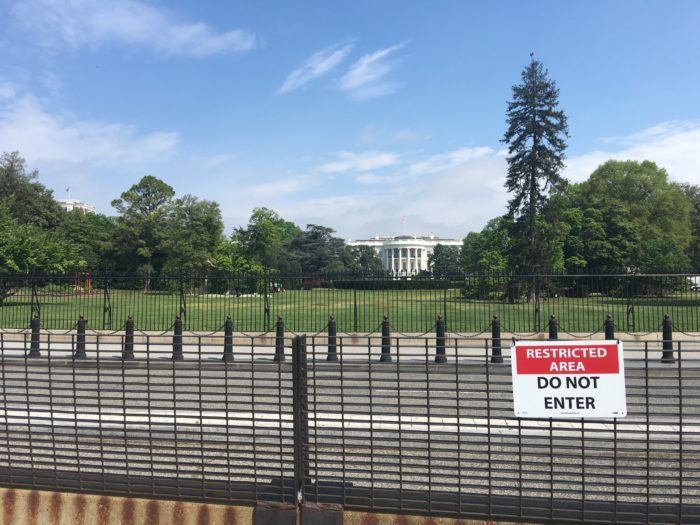
We’ve been tracking the Trump administration’s record on open government since Election Day 2016, when we first posed questions about what open government would mean. Although the Office of the Press Secretary never returned our inquiries, the administration’s actions have answered many of our questions. This is a secretive administration, allergic to transparency, shadowed by global conflicts of interest, hostile to the essential role journalism plays in a democracy.
In March 2017, Sunlight joined C-SPAN to make sense of the Trump administration’s record on open government for Sunshine Week, pulling together a list of examples for the producers that had established one of the worst records on open government in the first 100 days of an administration in American history, below, which we kept adding to in the weeks and months since.
The Trump administration’s bleak record on open government was once again subject to widespread national criticism during Sunshine Week 2018. From a blistering editorial from USA Today to a bleak report in the Washington Post on the “information darkness” of the Trump administration, the assessment of regression was unanimous.
At the beginning of the week we joined Public Citizen, Open the Government and others open government advocates in highlighting an “eclipse” of sunlight over the past year with some transparency art at the Justice Department headquarters in DC. You can see the animation above.
In fact, the Trump administration swept the 2018 open government infamous awards season, from the Electronic Frontier Foundation’ “Foilies” to the Society for Professional Journalists’ Black Hole Award to the National Security Archives’ Rosemary Awards.
In sum, the record now includes the most ignominious collection of denunciations that we’ve seen in modern history of an American presidency. The record now includes failures across transparency, accountability and ethics at home, and an international record that has undermined press freedom (CPJ), anti-corruption efforts, trust in the United States government, the word of the President, and the office of the presidency itself.
As we have highlighted from Inauguration Day onwards, this administration has consistently shadowed the public’s right to know, online and off – unless that transparency was used against its political opponents or to attempt to cast doubt on the legitimacy of the investigation into his campaign.
In the CNBC video embedded below, you can see nine ways Trump won’t embrace transparency.
Sunlight’s Record of the First 100 Days:
- How candidates conduct campaigns and transitions carries into office. After making himself available to the press through July, Trump set a bar as the least transparent modern presidential candidate in modern history. He held no press conference until from July 2016 until January 11, 2017, released no tax returns, and made no proactive disclosures around transition or inauguration. He held his first and only solo presidential press conference on February 16, 2017.
- Ethics: Lack of disclosure of tax returns and divestment in accordance with decades of tradition set up the Trump presidency for the ongoing appearance of corruption, with an unknown number of conflicts of interest around the world.
- Secret waivers for administration officials, followed by the Office of Management and Budgets seeking to block the Office of Government Ethics from making a data call to obtain them.
- No affirmative vision for open government. No public statements on the Freedom of Information Act, open government, open data, transparency, nor this year’s Sunshine Week. No whitehouse.gov/open.
- Keeping the White House visitor logs secret
- Congress voted to remove an anti-corruption rule, which President Trump signed with fanfare, abandoning U.S. leadership on transparency of payments by the extractive industries to government
- Secret gag orders to agencies
- Historic attacks on the role of the free press in democracy, with exclusion of American press on trips abroad.
- WhiteHouse.gov was missing policy documents, at launch. Executive orders postedlate. No OIRA website or dedicated OMB website or pages.
- No US chief technology officer, nor any evidence of plans for one, along with hundreds of key appointees not submitted to the Senate, including the U.S. chief information officer, chief science advisor and dozens of other science and technology policy roles.
- The President claimed to have made the most transparent selection of a nominee to be a Supreme Court Justice, given the campaign disclose of lists of potential nominees. When it came to announce his nominee, however, the White House tried to mislead out the press about another choice.
- Antagonism to government statistics and evidence: President Trump repeatedly said federal jobs numbers were “phony” as a candidate but now were valid.
- Levied attacks on the independent judiciary after judges struck down his executive order as unconstitutional.
- Moved drones used in counterterrorism back to CIA, away from accountability and transparency at Department of Defense.
- Secrecy around deregulation teams at agencies, with conflicts of interest.
- A bans on recording at White House press briefing. No Wh.gov/live stream of briefing or archive of video on YouTube, as under the Obama administration. [Wh.gov/live, recorded briefings and YouTube all became functional later in 2017.]
- No disclosure of Trump campaign official contacts with Russian nationals until after journalists reported them. No public address to the American public by the President explaining what Russia did, why the candidate urged Russia to find his political opponent’s email, or what the United States would do in response.
Please send us your stories of more positive or negative examples of transparency and accountability under President Trump.

